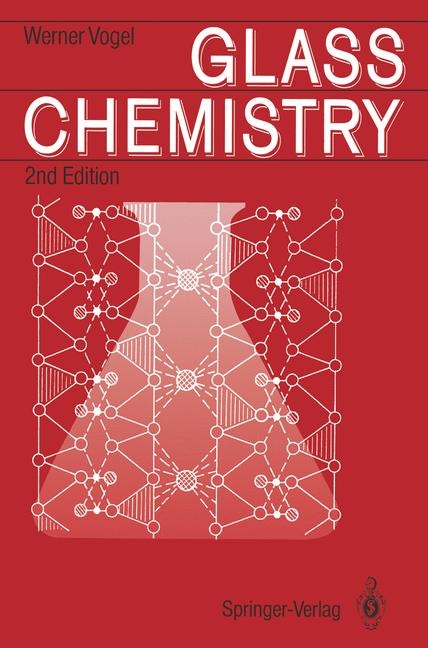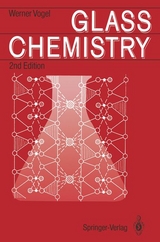Glass Chemistry
Springer Berlin (Verlag)
978-3-540-57572-6 (ISBN)
- Titel ist leider vergriffen;
keine Neuauflage - Artikel merken
Glass Chemistry is concerned with the relation of chemical composition, structure and properties of various glasses. The book has been translated from the third German edition, which serves as a textbook for university students in materials sciences and a reference book for scientists and engineers in glass science and production. The central themes of the book are the chemistry and physics of glass. Detailed knowledge of the compositional and structural facts is the basis for the systematic development of new glasses as construction and optical materials.Glass Chemistry is an interdisciplinary book on the borderlines between chemistry, physics, mineralogy and even biology and medicine. The book represents a well balanced treatment for students, scientists and engineers.
1 Historical Development of Glass Chemistry.- 1.1 The Beginnings of Glass Research.- 1.2 History of the Chemistry of Optical Glass.- 1.2.1 Ernst Abbe and Otto Schott.- 1.2.2 Carl Zeiss and the Zeiss Foundation.- 1.2.3 The Development of New Optical Glasses after 1939.- 1.3 History of Technical Glass.- 2 Freezing of a Melt to a Vitreous Solid.- 2.1 Fusion and Crystallization. General.- 2.2 Significant Differences Between Crystalline and Non-crystalline (Glassy) Solids.- 2.3 Standard Viscosity Temperatures for Solidification of Glasses.- 2.4 Annealing of Optical Glass.- 3 Structural Elements of Silicates.- 3.1 The SiO4 Tetrahedron as the Basic Building Block of Silicates.- 3.2 Building Units of Natural Crystalline Silicates.- 4 Classical Theories of Glass Structure.- 4.1 Glass Structure According to Tammann (since 1903).- 4.2 Glass Formation According to Goldschmidt.- 4.3 The Zachariasen-Warren Network Theory.- 4.4 Extension of the Network Theory by Dietzel.- 4.5 Additional Concepts Supplementing the Network Theory.- 4.6 Lebedev’s Crystallite Theory.- 4.7 Further Development of the Crystallite Theory.- 4.8 Kinetic Theory.- 5 Methodology in Glass Research.- 5.1 Structure of Liquids and Melts.- 5.2 The Nuclear Magnetic Resonance Method as Applied to Glass Research.- 5.2.1 Introduction.- 5.2.2 Basic NMR Theory.- 5.2.3 Dipolar Interaction.- 5.2.4 Chemical Shift.- 5.2.5 Quadrupole Interaction.- 5.3 Electron Microscopy.- 5.3.1 Introduction.- 5.3.2 Relations Between Light and Electron Microscopy.- 5.3.3 Imaging and Preparation of Samples.- 5.3.3.1 Direct Penetration of the Sample by Electrons.- 5.3.3.2 Carbon Replica Method after Bradley.- 5.3.3.3 Further Development of the Experimental Technique of Bradley’s Carbon Replica.- 5.3.3.4 Treatment of Glass Surfaces Prior to Replication.- 5.3.4 The Scanning Electron Microscope and Electron Microprobe.- 6 Microphase Separation.- 6.1 Early History.- 6.2 Electron Microscopy Evidence for Immiscibility Phenomena in Glasses.- 6.3 Theoretical Treatment.- 6.3.1 Thermodynamics of Phase Separation. General (Kortüm).- 6.3.1.1 Conditions of Equilibrium and Stability.- 6.3.1.2 Derivation of Stability Conditions for a Binary Mixed Phase.- 6.3.1.3 Characterization of the Regions of Immiscibility in Binary and Ternary Systems.- 6.3.2 Thermodynamics of Immiscibility in Glasses.- 6.3.3 Kinetics of Immiscibility in Glasses.- 6.4 Experimental Evidence.- 6.4.1 Functional Change of Microphases.- 6.4.2 Multiple Phase Separation.- 6.4.3 Shells around Microphases.- 6.4.4 Droplet Agglomeration after Secondary Phase Separation.- 6.4.5 Composition of Microphases and Distribution of Heavy Metal Ions.- 6.4.6 General Conclusions on Immiscibility Behavior and Microstructure.- 6.4.7 Control of Phase Separation.- 7 Structure and Properties of Colorless Glasses.- 7.1 Silica Glass.- 7.2 Alkali Silicate Glasses.- 7.2.1 The Mixed-Alkali Effect.- 7.3 Alkaline Earth and Alkali-Alkaline Earth Silicate Glasses.- 7.4 Borate and Borosilicate Glasses.- 7.4.1 Binary Alkali Borate Glasses. The “Boron Anomaly”.- 7.4.1.1 Temperature Dependence of the Boric Acid Anomaly.- 7.4.1.2 Tendency Toward Immiscibility.- 7.4.1.3 Present State of Interpretations of the “Boron Anomaly”.- 7.4.2 Borosilicate Glasses.- 7.4.2.1 The Ternary System Na2O-B2O3-SiO2.- 7.4.2.2 Vycor-Type Glasses.- 7.4.2.3 Pyrex-Type Glasses.- 7.5 Glasses of High Lead Content.- 7.5.1 Glass Formation in Lead-Containing Systems.- 7.5.2 Phase Separation in Glasses Containing Lead.- 7.5.3 Structurally Conditioned Coloration of High-Lead Silicate Glasses.- 7.6 Phosphate Glasses.- 7.6.1 Structure of Phosphate Glasses.- 7.6.2 Phase Separation in Pure Phosphate Glasses.- 7.7 Tellurite Glasses.- 7.7.1 Glass-Formation Range and Optical Properties of Tellurite Glasses.- 7.7.2 Structure of Tellurite Glasses.- 7.8 Beryllium Fluoride Glasses — “Model Glasses”.- 7.8.1 Theoretical Discussion of “Model Glasses”.- 7.8.2 Ranges of Glass Formation in BeF2 Model Systems. Properties of These Glasses.- 7.8.2.1 Density Plots.- 7.8.2.2 Refractive Index Plots.- 7.8.3 Phase Separation in Pure BeF2 Glasses.- 7.8.4 Fluoride Glasses Free of Beryllium.- 7.8.5 Fluorophosphate Glasses.- 7.9 Zirconium Fluoride Glasses.- 7.9.1 Glass Formation, Structure and Properties.- 7.10 Germanate Glasses.- 7.10.1 Glass Formation from GeO2 and Germanate Melts.- 7.10.2 Structure and Properties.- 7.11 Glasses Containing Arsenic Oxide.- 7.11.1 Glass Formation.- 7.11.2 Structure and Properties of Glasses of High Arsenic Oxide Content.- 7.12 Glasses Containing Antimony Oxide.- 7.12.1 Glass Formation and Some Important Properties.- 7.12.2 Structure.- 7.13 Glasses Containing Bismuth Oxide.- 7.14 Limited Glass Formation in Systems of Exclusively Scientific Interest.- 7.14.1 Titanate Glasses.- 7.14.2 Vanadate Glasses.- 7.14.3 Nitrate Glasses.- 7.14.4 Carbonate Glasses and Glasses Based on ZnCl2.- 7.14.5 Oxyhalide Glasses.- 7.14.6 Oxynitride Glasses.- 7.14.7 Oxycarbonate Glasses.- 7.14.8 High-H2O Glasses.- 7.15 Metal Glasses.- 7.16 Vitreous Carbon.- 7.17 The Sol-Gel Method for Production of Glasses and Glass Ceramics.- 7.17.1 Introduction.- 7.17.2 The Alkoxide Sol-Gel Method.- 7.17.3 The Silica Hydrosol Process.- 7.17.4 The Ormocer Method.- 7.17.5 The Importance and Application of Gel Glasses.- 8 New Optical High-Performance Glasses.- 8.1 Fundamental Principles of the Dispersion Behaviour of Glasses.- 8.2 Change of the Dispersion with the Introduction of Additional Absorption Centers.- 8.3 Optical Glasses with Unusual Partial Dispersions.- 8.4 Athermal Optical Glasses.- 8.5 Non-linear Refraction.- 8.6 Prerequisites on the Raw Material for the Production of Optical Glasses.- 9 Structure and Properties of Colored Glasses.- 9.1 General.- 9.2 Absorption of Colorless Base Glasses.- 9.3 Glasses Colored by Ions.- 9.3.1 Dependence of Absorption on Network-Former.- 9.3.2 Dependence of Absorption on Modifiers.- 9.3.3 Dependence of Absorption on the Valency of the Chromophore.- 9.3.4 Dependence of Absorption on the Coordination Number of the Chromophore.- 9.3.4.1 Coordination Change Due to Change in Chromophore Concentration.- 9.3.4.2 Coordination Change of Chromophore Due to Concentration Change of Network-Modifier.- 9.3.4.3 Coordination Change of Chromophore Due to Changed Network-Former.- 9.3.5 Problems of Interpretation.- 9.3.6 Technologically Important Chromophores and Selected Transmission Curves.- 9.4 Striking Glasses.- 9.4.1 Composition, Preparation, and Absorption Behavior.- 9.4.2 Base Glass Structure and Coloring Mechanism in “Striking” Glasses.- 9.4.3 Coloring Mechanism in Striking Glasses.- 9.4.4 Related Glasses with Other Chromophores.- 9.5 Glasses Colored by Metal Colloids (Ruby Glasses).- 9.5.1 Composition, Fabrication, and Absorption Behavior.- 9.5.2 Structure and Coloring Mechanism in True Ruby Glasses.- 9.5.3 Silver Stain.- 9.6 IR-Absorbing Glasses (Heat-Absorbing Glasses).- 9.6.1 Application of Heat-Absorbing Glasses and Absorption Behavior of Glasses Containing Fe2+ and Fe3+ Ions.- 9.6.2 Development, Production, and Properties of Heat-Absorbing Glasses.- 9.7 IR-Transmitting Glasses.- 9.7.1 IR-Transmission of Solids.- 9.7.2 IR-Transmission of Germanate, Tellurite, and Aluminate Glasses.- 9.7.3 IR-Transmitting Chalcogenide Glasses.- 9.7.3.1 Arsenic Sulfide Glasses.- 9.7.3.1 Other Chalcogenide Systems.- 9.8 Opacified Glasses.- 9.8.1 Mechanisms of Opacification.- 9.8.2 History and Classification of Opacified Glasses.- 9.8.3 Phosphate Opal Glasses.- 9.8.4 Fluorine Opal Glasses.- 9.8.5 Opal Glasses Based on SnO2, TiO2, ZrO2, CeO2, ZnO, and Other Compounds.- 9.8.6 Light Scattering and Color of Microdisperse Two-Phase Glasses.- 10 Crystallization of Glasses.- 10.1 General.- 10.2 Theoretical Considerations.- 10.2.1 Homogeneous Nucleation.- 10.2.2 Heterogeneous Nucleation.- 10.2.3 Crystal Growth.- 10.3 Crystallization as a Defect in Glass.- 10.4 Controlled Crystallization.- 10.4.1 Principles of Controlled Crystallization.- 10.4.2 Pioneering Developments at Corning Glass Works.- 10.4.2.1 Glass Ceramics with Minimal Coefficients of Thermal Expansion.- 10.4.2.1.1 Composition, Production, and Application.- 10.4.2.1.2 Structure and Properties.- 10.4.2.2 Machinable Glass Ceramics.- 10.4.2.2.1 General, Composition, Production.- 10.4.2.3 New Mica-Containing Glass Ceramics.- 10.4.2.4 Chain Silicate Glass Ceramics.- 10.4.2.5 Strengthening of a Special Glass by the Chemcor Process.- 10.4.3 Fundamental Investigations in the Development of Glass-Ceramics at the Otto Schott Institute of the Friedrich Schiller University in Jena.- 10.4.3.1 Nucleation and Crystallization Kinetics of a Base Glass from the Mg0-Al203-Si02 System.- 10.4.3.2 Doping of the Base Glass with 11.2 mol% Fluorine Ions.- 10.4.3.3 High-Strength Glass Ceramics Containing Spinel.- 10.4.3.4 Single Doping of the Base Glass with 2-10 mol% TiO2 (Ti2O3) also Leads to High Strength Glass Ceramics.- 10.4.3.5 Double Doping of the Base Glass with 11.2 mol % F and 5.2 mol % Na2O Yields Machinable Glass Ceramics.- 10.4.3.6 Ferrimagnetic Glass Ceramics.- 10.4.4 Development of Bioglass Ceramics for Medicine.- 10.4.4.1 Introduction.- 10.4.4.2 Development of Bioglass Ceramics, Present State, Requirements and Targets.- 10.4.4.3 Development of Biocompatible and Machinable Glass Ceramics.- 10.4.4.4 Development of Bioactive Glass Ceramics.- 10.5 Bioactive, Piezoelectric, Phosphate Glass Ceramics Free of Silica.- 10.5.1 Development Trends of Phosphate Glass Ceramics.- 10.5.2 Structure and Crystallization Behavior of Phosphate Glasses.- 10.5.3 Development of Pure Biophosphate Glass Ceramics.- 10.5.4 Animal Experiments at the Academy of Medicine of Dresden on the Intergrowth Between Phosphate Glass-Ceramic Implants and Bones.- 10.5.5 Clinical Tests of the New Bioglass Ceramics on Humans.- 10.5.6 Summary and Outlook.- 10.6 Sintered and Special Glass Ceramics.- 10.6.1 Sintered Glass Ceramics.- 10.6.2 Special Glass Ceramics.- 11 The Strength of Glass.- 11.1 Theoretical Strength.- 11.2 Effective Strength: Attempts at Theoretical and Practical Explanations.- 11.2.1 Theoretical Concepts Regarding the Strength of Glass.- 11.2.2 Experimental Investigations.- 11.2.2.1 A Demonstration of Griffith Flaws.- 11.2.2.2 Strength After Elimination of Crude Surface Defects.- 11.2.2.3 Fatigue.- 11.2.2.4 Aging.- 11.2.3 The Strength of Glass Fibers.- 11.3 Strengthening Methods in Practice.- 11.3.1 Tempering.- 11.3.2 Compound Glass.- 11.3.3 Silicon-Organic Coatings.- 11.3.4 Dealkalizing.- 11.3.5 Ion Exchange: “Chemical Strengthening”.- 11.3.6 Multiple Layer Glass.- 12 Interaction Between High Energy Radiation and Glass.- 12.1 General Considerations.- 12.2 Photosensitive Glasses Based on the Formation of Metal Colloids.- 12.3 Photosensitive Glasses Based on Partial Crystallization in Lithium and Barium Silicate Systems.- 12.3.1 Composition and Preparation.- 12.3.2 Structure, Properties, and Microprocesses.- 12.3.3 Special Properties and Applications, Photoform, Photoceram.- 12.3.3.1 Photoform.- 12.3.3.2 Photoceram.- 12.4 Dosimeter Glasses.- 12.5 Photochromic Systems and Glasses.- 12.5.1 Requirements of Photochromic Systems.- 12.5.2 Combination of Photochromic Organic Compounds and Glass.- 12.5.3 Inorganic Photochromic Glasses.- 12.5.3.1 Development and Application.- 12.5.3.2 Photochromic Glasses Activated by Rare Earths.- 12.5.3.3 Borosilicate Glasses Doped with Silver Halides.- 12.5.3.4 Borosilicate Glasses Doped with Silver Molybdate and Tungstate.- 12.5.3.5 Borosilicate Glasses Doped with Copper or Cadmium Halides.- 12.5.3.6 Thermally Darkening Photochromic Glasses (“TDPC”).- 12.6 Laser Glasses.- 12.6.1 Introduction.- 12.6.2 Light Absorption and Light Emission in Solids.- 12.6.3 The Solid Laser.- 12.6.3.1 Laser Principle — Oscillator — Optical Pumps.- 12.6.3.2 Mode of Operation of Lasers.- 12.6.3.3 Properties of a Solid Laser Material.- 12.6.4 Efficiency Increase by Sensitization.- 12.6.5 Applications of Lasers.- 12.7 Radiation Protection and Radiation-Resistant (“Protected”) Glasses.- 12.8 Transmission Changes of Colored Glasses under ? Irradiation.- 12.9 Solarization.- 13 Survey of the Physical Basis of Some Glass Properties.- 13.1 Introduction.- 13.2 Refraction of Light, Dispersion and Abbe’s Value.- 13.3 Density.- 13.4 Molar Refraction.- 13.5 Thermal Expansion.- 13.6 Viscosity.- 13.7 Strain.- 13.8 Surface Tension.- 13.9 Heat Conductivity, Specific Heat.- 13.10 Electrical Conductivity.- References.
| Übersetzer | N. Kreidl, M. Lopes Barreto |
|---|---|
| Zusatzinfo | XIV, 464 p. |
| Verlagsort | Berlin |
| Sprache | englisch |
| Maße | 155 x 235 mm |
| Gewicht | 918 g |
| Themenwelt | Naturwissenschaften ► Chemie ► Anorganische Chemie |
| Schlagworte | Ceramics • Crystal • Glas • Glass • Materials Science • Mineralogy • Na2O • Network Theory • Nonmetallic Materials • SiO2 • Sol-Gel • thermodynamics |
| ISBN-10 | 3-540-57572-3 / 3540575723 |
| ISBN-13 | 978-3-540-57572-6 / 9783540575726 |
| Zustand | Neuware |
| Informationen gemäß Produktsicherheitsverordnung (GPSR) | |
| Haben Sie eine Frage zum Produkt? |
aus dem Bereich




